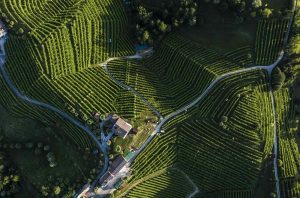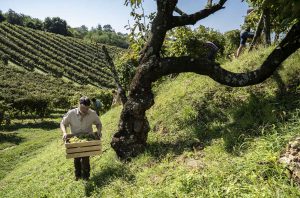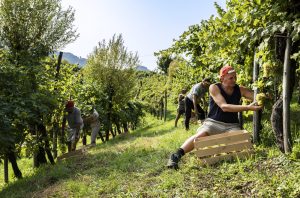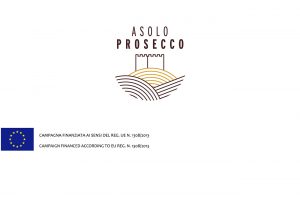Asolo Prosecco was born on the mountainous hills surrounding Asolo, often called ‘the town of a hundred horizons’ thanks to its expansive views. It’s an ancient settlement, rich in art and history, recognised as one of the most beautiful villages in Italy. Its vineyards are also internationally recognised for a wine with elegant bubbles, a pleasant freshness and a distinct aromatic profile, making it perfect as an aperitif or to toast special occasions.
Rich history
Asolo was founded in Roman times and developed considerably in the Middle Ages. In the 14th century, Asolo and its surroundings were annexed and became part of the Serenissima Republic of Venice. It was during this era that the town’s architectural splendour developed and the region established its excellence in viticulture.
Wines from Asolo’s hills were considered to be of the highest quality, and were subsequently taxed a third more than other regions. Today, a glass of Asolo Prosecco is still held in high esteem, carrying a unique heritage, the result of centuries-old traditions, ancient knowledge and a unique terroir.

A precious landscape
In 2021, the region around Asolo was recognised by the UNESCO Man and Biosphere Programme (MAB), and Monte Grappa designated as Biosphere Reserve. The landscape famed for its traditional products, such as Bastardo di Grappa, local cheeses and of course Asolo Prosecco, forms a biological corridor connecting to the Po Valley and the south-eastern alps.
The region earned the award for its leading role in environmental awareness and for measures taken to mitigate air pollution, and conserve biodiversity. It’s a shining example of a local solution to global challenges, and Italy can boast twenty of these splendid examples, including the Po Delta, Monviso, the islands of Tuscany, the Sila and Cilento.
One of a kind
The production area of Asolo Prosecco is located in the province of Treviso, at the foot of Monte Grappa, on the high hills to the west of the Piave, close to the Dolomites and Montello. The grape cultivation area includes Asolo and 17 other municipalities around it. Here, the vineyards mingle with the woods, in a fascinating and fairytale-like hilly scene.
Of the total 43,507 hectares encompassed by the denomination’s municipalities, the vineyards of Asolo Prosecco only make up 6.2% of the total surface area (2,708 ha), underscoring the importance of biodiversity in the area. An extraordinary wealth of vegetation grows here too, thanks to the area’s climate, which uniquely balances the influence of Mediterranean temperatures with breezes from the Adriatic sea and cooler air from the nearby mountains. It is also one of the northernmost areas of the world where olive trees are grown.

Uniquely local
Asolo Prosecco is an appellation of heroic viticulture. Growing grapes on the steep terrain of the Asolo hills requires strenuous viticultural efforts, as incredibly inaccessible vineyards can only be worked by hand while offering very limited yields. Tenacious, seasoned pickers select only the best grapes during the back-breaking harvest.
Glera, a vine documented to have been grown in the Treviso area for hundreds of years, is the dominant grape in the region and the main component of Asolo Prosecco. With an extraordinary ability to adapt to the Asolo territory, Glera provides the backbone of character for Asolo Prosecco.
Other ancient local varieties also contribute to the unique flavour profile of Asolo Prosecco, and can make up a maximum of 15% of the final blend. The grapes used are: Bianchetta Trevigiana, which has been mentioned in sixteenth- century documents; Verdiso, which has been documented in the Treviso area since the eighteenth century; Perera, which is mentioned in nineteenth- century texts; and Glera Lunga, an ancient variety of Glera that is naturally lower yielding than the more widely used Glera Tonda, which only saw its autonomous ampelographic identity officially recognised a few years ago.

Wine of character
Thanks to Asolo Prosecco’s strongly identifiable character, its unique terroir, and the care taken by local winemakers’ care to protect the landscape, it was recognised as a DOCG in June 2009. The elegant and refined characteristics that make Asolo Prosecco such an appealing sparkling wine are well known by enthusiasts.
On the nose, you’ll find a floral and fruity bouquet, accompanied by a subtle and refreshing vegetal vein. On the palate, the wine is soft and balanced, with a delicate body, a marked and well-integrated freshness, and dry finish. Citrus notes of lemon and cedar, meet fine and delicate notes of honey, whilst hints of ripe apple and white flowers stand out.
Asolo Prosecco is produced in a variety of styles, but the DOCG was the first, in the great panorama of Prosecco, to introduce the Extra Brut category, particularly representative of Asolo’s elegance and purity. Distinguishable by its complexity and finesse, Asolo Prosecco offers something quite special and memorable.
Discover more about Asolo Prosecco
Connect on
Facebook | Instagram








